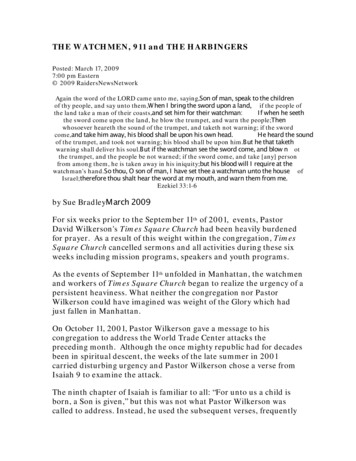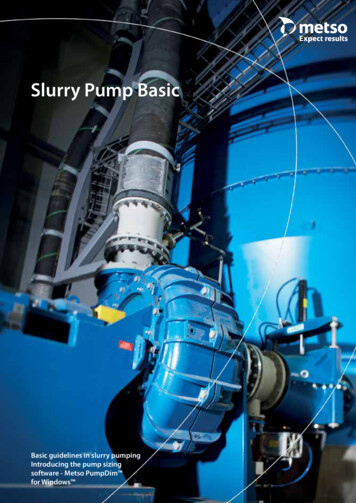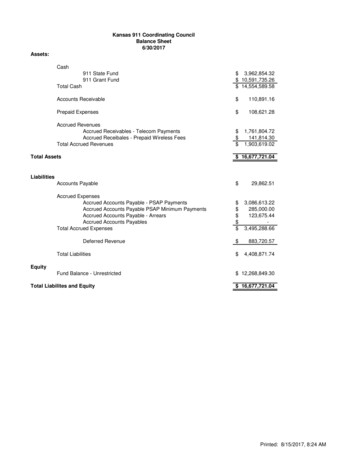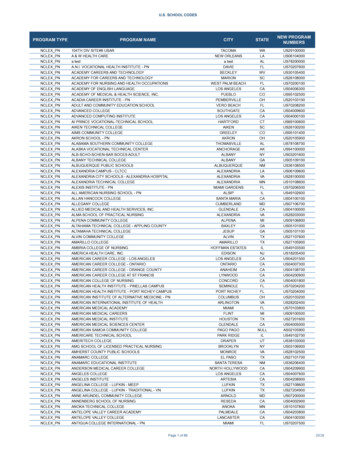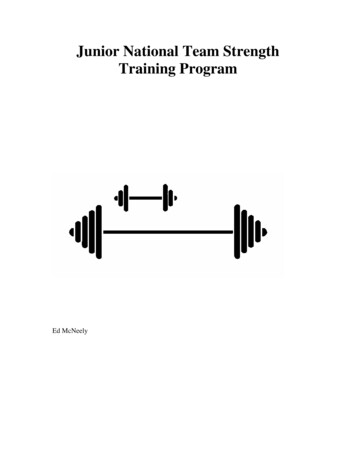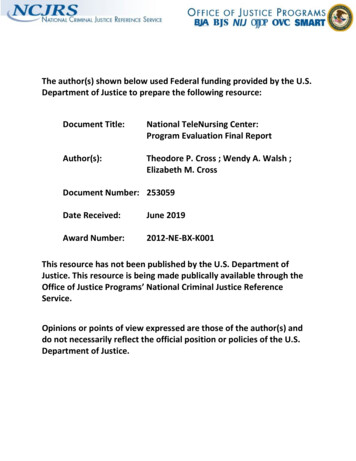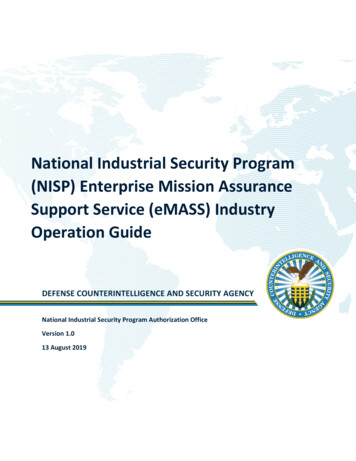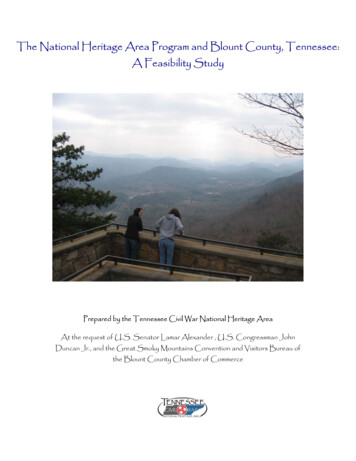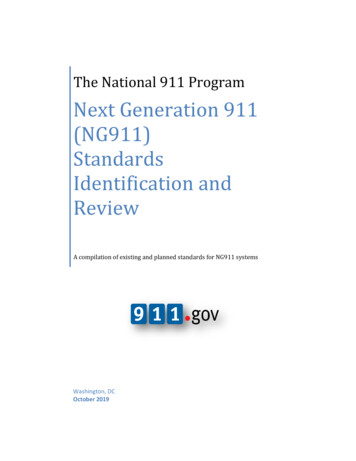
Transcription
The National 911 ProgramNext Generation 911(NG911)StandardsIdentification andReviewA compilation of existing and planned standards for NG911 systemsWashington, DCOctober 2019
Next Generation 911 (NG911) Standards Identification and ReviewDOCUMENT CHANGE HISTORYThe table below details the change history of this Standards Identification and Review document.Version1.02.03.0Publication DateSeptember 21, 2011September 7, 2012January 8, 20144.0March 4, 20155.0March 20166.0March 20177.0April 20188.0July 2019DescriptionInitial ReleaseUpdated StandardsRoutine Revision / UpdatedStandardsRoutine Revision / UpdatedStandardsRoutine Revision / UpdatedStandardsRoutine Revision / UpdatedStandardsRoutine Revision / UpdatedStandardsRoutine Revision / UpdatedStandardsThis publication is distributed by the U.S. Department of Transportation, National HighwayTraffic Safety Administration, in the interest of information exchange. The opinions, findingsand conclusions expressed in this publication are often referenced and reported directly from theoriginal source and are not necessarily those of the Department of Transportation or the NationalHighway Traffic Safety Administration. The United States Government assumes no liability forits content or use thereof. If trade or manufacturer’s names, products or mission statements arementioned, it is because they are considered essential to the object of the publication and shouldnot be construed as an endorsement. The United States Government does not endorse products,services, manufacturers or companies.Page i
Next Generation 911 (NG911) Standards Identification and ReviewTable of ContentsIntroduction . 1What Is a Standard? . 2What Are Best Practices?. 3Stakeholders . 3Standards Organizations . 4How Are Standards Developed? . 4What Is Standards Accreditation? . 5Types of Standards . 6The Need for Standards in NG911. 6Standards Affecting NG911. 7What’s New in Standards. 73rd Generation Partnership Project (3GPP) . 73rd Generation Partnership Project (3GPP2) . 7Alliance for Telecommunications Industry Solutions (ATIS) . 7Association of Public-Safety Communication Officials (APCO) . 8Building Industries Consulting Service International (BICSI) . 9Department of Commerce (DOC) . 9Department of Homeland Security (DHS) . 9Department of Justice (DOJ) . 10Information Security Forum (ISF) . 10Institute of Electrical and Electronic Engineers (IEEE). 10International Organization for Standardization (ISO) . 10National Emergency Number Association (NENA) . 10National Fire Protection Agency (NFPA) . 11Society of Cable Telecommunications and Engineers (SCTE) . 11USTelecom . 12Standards and Best Practices Organizations . 123rd Generation Partnership Project (3GPP) . 13American National Standards Institute (ANSI) . 16Association of Public-Safety Communications Officials (APCO) . 18Alliance for Telecommunications Industry Solutions (ATIS) . 22Page ii
Next Generation 911 (NG911) Standards Identification and ReviewBroadband Forum (BBF) . 28Building Industries Consulting Service International (BICSI) . 30CableLabs . 31Commission on Accreditation for Law Enforcement Agencies (CALEA). 33Department of Commerce (DOC) . 34Department of Energy (DOE) . 37Department of Homeland Security (DHS) . 39Department of Justice (DOJ) . 42Department of Transportation (USDOT) . 43European Telecommunications Standards Institute (ETSI) . 45Federal Communications Commission (FCC) . 47Federal Geographic Data Committee (FGDC). 53Industrial Internet Consortium (IIC) . 54Information Security Forum (ISF) . 55Information Sharing and Analysis Organization (ISAO). 57Institute of Electrical and Electronics Engineers (IEEE) . 59Internet Engineering Task Force (IETF) . 62International Academies of Emergency Dispatch (IAED) . 67International Organization of Standardization (ISO) . 68International Telecommunication Union (ITU) . 70ISACA . 72National Emergency Number Association (NENA) . 76National Fire Protection Association (NFPA) . 81National Information Exchange Model (NIEM) . 82North American Electric Reliability Corporation (NERC) . 84Object Management Group (OMG ) . 85Organization for the Advancement of Structured Information Standards (OASIS) . 87Open Geospatial Consortium (OGC ) . 88Open Mobile Alliance (OMA) . 90Standards Coordinating Council (SCC) . 92Society of Cable Telecommunications Engineers (SCTE) . 95Telcordia. 98Telecommunications Industry Association (TIA) . 100USTelecom . 103Page iii
Next Generation 911 (NG911) Standards Identification and ReviewWi-Fi Alliance . 104WiMAX Forum . 105Moving Forward . 106Acronym List . 107Appendix A: Standards and Best Practices . A-1Appendix B: Standards Gap Analysis. B-1Page iv
Next Generation 911 (NG911) Standards Identification and ReviewIntroductionOne of the most critical aspects of transforming the nation’s public safety answering points(PSAPs) from today’s legacy 911 technology to Next Generation 911 (NG911) is adherence to acommon set of standards. Development and adoption of international standards is key to achieving911 interoperability across multiple local, regional, state, and national public safety jurisdictions,and beyond into the global emergency communications environment. Based on conceptualdefinitions dating from 2000, development began on NG911 standards in 2003 when the NationalEmergency Number Association (NENA) initiated technical requirements and definition work oncore Internet Protocol (IP) functionality and architecture.Beyond the walls of the 911 PSAPs, the consistent observance of standards is essential inaccomplishing seamless transmission of data from the caller to 911, and on to emergencyresponders. As PSAPs expand the forms of data they receive and transmit to each other, and asemergency responders migrate to a broadband network (e.g., FirstNet), it is essential that standardsare established and consistently adopted.A variety of standards already exist, and many are actively under development. However, there islimited coordination across the broad NG911 community regarding what completed standards areavailable, what standards overlap, and what standards still need to be established. The National911 Program, led by the United States (U.S.) Department of Transportation (USDOT), NationalHighway Traffic Safety Administration (NHTSA), has compiled this list of standards activitiesrelated to NG911. The standards development organizations (SDOs) mentioned herein were giventhe opportunity to vet the contents of this document, to assess the status of specific standards. Thisis a living document, and the National 911 Program will publish, 1 monitor, support, and promotethe activities of SDOs in establishing a comprehensive set of standards for NG911.The hyperlinks to the standards identified in this document, unless otherwise noted, were verifiedon July 11, 2019.Input from the standards community and NG911 stakeholders at large is encouraged andappreciated. The National 911 Program can be reached at (202) 366-3485 or via email at:nhtsa.national911@dot.gov.1Available through the National 911 Program at: http://www.911.gov.Page 1
Next Generation 911 (NG911) Standards Identification and ReviewWhat Is a Standard?The International Organization for Standardization (ISO)/International ElectrotechnicalCommission (IEC) Guide 2:2004, definition 3.2, defines a standard as a 2—document, established by consensus and approved by a recognized body,that provides, for common and repeated use, rules, guidelines orcharacteristics for activities or their results, aimed at the achievement ofthe optimum degree of order in a given contextStandards affect the daily lives of everyone across the nation. From the most mundane aspects oflife (e.g., electrical cords and wall sockets) to potentially life and death situations (e.g., theconcentration of ingredients in generic medications), standards guide the quality, safety, andsecurity of products or processes. Standards are widely used in all areas throughout the U.S.government and public and private sectors.Standards can be voluntary—by themselves imposing no requirement regarding use—ormandatory. Generally, a mandatory standard is published as part of a code, rule, or regulation bya regulatory government body and imposes an obligation on specified parties to conform to it.However, the distinction between these two categories may be lost when voluntary consensusstandards are referenced in government regulations, effectively making them mandatorystandards. 3 Most standards are voluntary, consensus-based, and open: 4 Voluntary—Use of the standard is not mandated by lawConsensus-based—Published standards have attained general agreement throughcooperation and compromise in a process that is inclusive of all interested partiesOpen—Standards are not proprietary and are available for anyone to useA standard may be or contain intellectual property such as patents, and the intellectual propertyrights (IPR) may still be held by a company. The American National Standards Institute (ANSI)essential elements state this about patents in ANSI standards:International Organization for Standardization (ISO), ISO/IEC Directives, Part 2: Rules for the structure anddrafting of International Standards. Available at: http://www.iec.ch/members ational Institute of Standards and Technology, The ABC’s of Standards Activities. Available at:http://ws680.nist.gov/publication/get pdf.cfm?pub id 903219.4Research and Innovation Technology Administration (RITA) Intelligent Transport Systems (ITS), What AreStandards? Available at: ds/ITSStandardsBackground.2Page 2
Next Generation 911 (NG911) Standards Identification and ReviewThe ASD shall receive from the patent holder or a party authorized to makeassurances on its behalf, in written or electronic form, either:a) assurance in the form of a general disclaimer to the effect that such party doesnot hold and does not currently intend holding any essential patent claim(s); orb) assurance that a license to such essential patent claim(s) will be made availableto applicants desiring to utilize the license for the purpose of implementing thestandard either:i) under reasonable terms and conditions that are demonstrably free of anyunfair discrimination; orii) without compensation and under reasonable terms and conditions that aredemonstrably free of any unfair discrimination.5What Are Best Practices?Typically less formal than standards, best practices are methods or techniques that have beenidentified as the most effective, efficient, and practical means to achieve an objective. Based on arepeatable process, best practices often emerge as the result of generally accepted principlesfollowed by many individuals, groups, or organizations, which have been established over time.Best practices often supplement the standards process and act as common guidelines for policiesand operations.StakeholdersStakeholders in standardization encompass all groups that have an interest in a particular standardbecause those groups are likely to be most affected by changes and, therefore, want to contributeto the development process. NG911 stakeholders are members of a broad and diverse communityof users who generally can be categorized as follows: 911 and public safety agencies and authoritiesVendor community (including hardware and software) and related industriesTechnology, services, and consulting industriesSDOs and standards setting organizations (SSOs)Consumer, research, academic, and consortia communitiesTelematics, third-party call centers, Internet, infrastructure, wireline, and wireless serviceprovidersTransportation agenciesLocal, state, and federal governmentsAmerican National Standards Institute (ANSI), ANSI Essential Requirements: Due process requirements forAmerican National Standards, January 2019. Available Procedures,%20Guides,%20and%20Forms/2019 ANSI Essential Requirements.pdf.5Page 3
Next Generation 911 (NG911) Standards Identification and Review Regulatory agencies and public utility commissionsProfessional and trade associationsThe public at large 6Standards OrganizationsStandards organizations are bodies, organizations, and institutions whose focus is developing andmaintaining standards in the interest of a user community. These organizations can begovernmental, quasi-governmental, and non-governmental. 7 Typically, their mandate isgeographically oriented—international, regional, or national. Organizations that establish, review,and maintain standards are considered to be SDOs, 8 although consortia are sometimesdifferentiated as SSOs. Generally speaking, SDOs and SSOs consistently adhere to a set ofrequirements or procedures that govern the standards development process.How Are Standards Developed?At the heart of the U.S. standards system are voluntary standards that arise from a formal,coordinated, consensus-based, and open process. Developed by subject matter experts from boththe public and private sectors, the voluntary process is open to all affected parties and relies oncooperation and compromise among a diverse range of stakeholders. Organizations also worktogether to develop joint standards, which forge relationships and allow for a collaborative andcooperative effort. Joint standards will be especially important with respect to the synergisticenvironment of emergency communications, such as the environment shared by the NationwidePublic Safety Broadband Network (NPSBN) and NG911.Although the development process may vary to some extent from organization to organization,fundamentally each organization has an established set of formally documented procedures forinitiating, developing, reviewing, approving, and maintaining standards. As an example, thefollowing diagram illustrates the USDOT Research and Innovative Technology Administr
Telematics, third-party call centers, Internet, infrastructure, wireline, and wireless service providers Transportation agencies Local, state, and federal governments. 5 American National Standards Institute (ANSI), ANSI Essential Requirements: Due process requirements for

